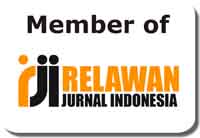‘Sontoloyo' and 'Genderuwo'; Critical Discourse Analysis on Jokowi’s Utterance
Abstract
This study discusses Joko Widodo’s utterance in several moments. Jokowi is the president of the Indonesian Republic. He would like to participate in the reelection of the presidential election in April 2019. Many statements of him make public perceptions appear different. In this case, there is two big points of research that can be famous dictions in this era. ‘sontoloyo’ and ‘genderuwo’ are two interesting dictions to discuss. As a popular person, Jokowi’s utterances occur as public discourses. Many perspectives are produced by many analysts in multidiscipline views. Critical Discourse Analysis (CDA) is used as a framework to analyze the utterances related to many perspectives of language. Fairclough model is a choice for analyzing in depth of the research. It states in three big points; text analysis (description), processing analysis (interpretation) andsocial analysis (explanation). The researcher uses a qualitative method. The data related with the sontoloyo and genderuwo utterance comes from news online the Jakarta Post. By using Fairclough theory, the researcher explains the text in the relationship with the situation of political moment, the speaker as government and candidate of the presidential election. The text gives many interpretation and relationship with the social condition.
Keywords
Full Text:
PDFReferences
Amin, M. F. (2014). Bahasa dan Ideologi: Mengungkap Ideologi Dan Kekuasaan Simbolik Di Balik Penggunaan Bahasa (Kajian Teks Media Melalui Analisis Wacana Kritis ), 19(1).
Brian Paltridge. (2012). Discourse Analysis (First). USA: British library cataloging.
Bukhari, N. H., & Xiaoyang, W. (2013). Critical Discourse Analysis and Educational Researchn. IOSR Journal of Research & Method in Education (IOSR-JRME), 3(1), 09–17.
Elya Munfarida. (2014). Analisis Wacana Kritis dalam Perspektif Norman Fairclough. KOMUNIKA: Jurnal Dakwah Dan Komunikasi, Vol 8(No 1), 1–19.
Fairclough, I. F., and N. (2012). Political Discourse Analysis.
Fairclough, N. (2003). Analyzing Discourse: Textual Analysis for Social Research (First). London and Newyork: Routledge.
Gunawan, F., & Sumarlam, S. (2018, November). The Polemic of Kendari Beach Reclamation on Online Media (Critical Discourse Analysis). In International Seminar on Recent Language, Literature, and Local Cultural Studies (BASA 2018). Atlantis Press.
Hussain, S. (2017). Critical Discourse Analysis : Demystifying the Fuzziness. The International Journal Of Humanities & Social Studies.
Jones, P. E. (2007). Why there is no such thing as “critical discourse analysis.” Language and Communication, 27(4), 337–368.
Jørgensen, M., & Phillips, L. (2002). Discourse Analysis as Theory and Method.
Kamasa, V. (2013). Naming “In Vitro Fertilization”: Critical Discourse Analysis of the Polish Catholic Church’s Official Documents. Procedia - Social and Behavioral Sciences, 95, 154–159.
Kusumawati, A. J. (2011). A Discourse Analysis Of SBY’ S International Speech Text : A Study On Critical. Journal of English and Education, 5(01), 1–28.
Mackey, A., & Gass, S. M. (2012). Research Methods in Second Language Acquisition (First). John Wiley & Sons, Ltd., Publication.
Maghvira, G. (2017). Critical Discourse Analysis At Tempo. Co on the News, 9(April), 120–130.
Norman Fairclough. (n.d.). Analysis The Critical Study of Language (Second Edi). Routledge.
Norman Fairclough. (1992). Language and Power (Fifth). London and Newyork: Longman.
PURBANI, W. (2009). Analisis wacana kritis dan analisis wacana feminis. Analisis Wacana, 1, 1–5.
Rahimi, F., & Riasati, M. J. (2011). Critical discourse analysis: scrutinizing Ideologically-driven discourses. International Journal of Humanities and Social Science, 1(16), 107–112.
Robert de Beaugrande, W. D. (1981). Introduction to Text Linguistics. Florida.
Sriwimon, L., & Zilli, P. J. (2017). Applying Critical Discourse Analysis as a conceptual framework for investigating gender stereotypes in political media discourse. Kasetsart Journal of Social Sciences, 38(2), 136–142.
Susanti, E. (2015). Hegemony of the Social Media Twitter about National Issues in Indonesia and its Implications to the Discourse Analysis Subject in Colleges. Tarbiya, 2(1), 153–166.
Tannen, D., Heidi E. Hamilton, A., & Schiffrin, D. (Eds.). (2015). How-to-Do-Critical-Discourse-Analysis-A-Multimodal-Introduction.pdf (Second, p. 236). USA, UK: Blackwell Publishers Ltd.
Xie, X., & Ding, Y. (2016). Framing iPhone Consumption by Chinese Mainlanders: Critical Discourse Analysis on News Coverage of China Daily and South China Morning Post. Procedia - Social and Behavioral Sciences, 236(December 2015), 39–45.
Zulkifli, C. N. (2015). The Construction of Career Women in Cleo: Critical Discourse Analysis. Procedia-Social and Behavioral Sciences (Vol. 208). Elsevier B.V.
DOI: http://dx.doi.org/10.31332/lkw.v5i1.1257
Copyright (c) 2019 Nanan Abdul Manan

This work is licensed under a Creative Commons Attribution-ShareAlike 4.0 International License.
Publisher:
UPT Pengembangan Bahasa, IAIN Kendari
Jln. Sultan Qaimuddin No. 17 Baruga, Kota Kendari, Sulawesi Tenggara
Website: upb.iainkendari.ac.id
Email: [email protected]


















